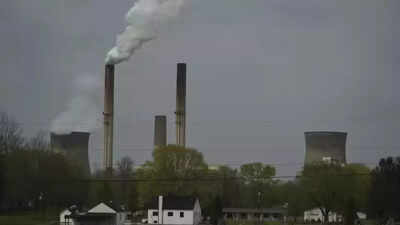ARTICLE AD BOX

BATHINDA: India is the world’s 3rd-largest methane emitter, with key sources including Livestock (enteric fermentation and manure) and rice cultivation. India emitted 31 Mt of methane in 2020, accounting for 9% of global emissions.
India’s agricultural methane emissions contribute 12% of global agricultural methane, making it one of the highest shares worldwide. Rice methane emissions in India are projected to increase by 8% between 2020–2030. India does not identify actions to reduce emissions from its largest methane source (agriculture) in its Nationally Determined Contributions (NDCs).BATHINDA: India is highlighted as a major hotspot for crop residue burning, despite global declines.
India is associated with waste management challenges that can initially raise methane emissions. The factors came top fore in the Global Methane Status Report (GMSR), 2025, released late Monday at Belem, Brazil during COP30. Agriculture is the largest source of global anthropogenic methane emissions, accounting for almost 42 per cent in 2020, with livestock and rice cultivation as the primary drivers. Without additional mitigation, emissions are expected to rise by 8 per cent by 2030 and 17 per cent by 2050, compared to 2020 levels.
In 2020, agriculture was the largest source of global biogenic methane emissions, responsible for 146 Mt per year or almost 42 per cent of the global total, slightly ahead of the energy sector. Livestock and rice cultivation dominate these emissions, contributing 76 per cent and 21 per cent respectively, while agricultural waste burning accounts for the remaining 3 per cent. Key opportunities include improved rice cultivation, for example, improved water management and sulphate use, which could reduce emissions by 9.8 Mt per year at negative cost by 2030, and banning the open burning of agricultural waste, which lower emissions by a further 4.7 Mt per year at zero cost, by 2030, finds the report. The GMRS shows that while considerable progress has been made since the launch of the Global Methane Pledge in 2021, more work is required to align with the level of ambition and action needed to meet the Pledge. Produced by the UN Environment Programme (UNEP) and the Climate and Clean Air Coalition (CCAC), the Global Methane Status Report provides a comprehensive assessment of progress and remaining gaps in efforts to cut methane - a potent greenhouse gas responsible for nearly a third of current warming. The report shows that although methane emissions are still rising, projected 2030 emissions under current legislation are already lower than earlier forecasts due to a mix of national policies, sectoral regulations, and market shifts. However, the report warns that only full-scale implementation of proven and available control measures will close the gap to the Global Methane Pledge’s target of a 30% cut from 2020 levels by 2030.
Urging decisive methane action to deliver the Global Methane Pledge, ministers attending the Global Methane Pledge Ministerial stressed that the policies, technologies, and partnerships needed to meet the target are available but require rapid scale-up across the energy, agriculture, and waste sectors. Ministers also called for increased transparency from countries on ambition and action to track progress.
The Global Methane Status Report offers the clearest picture yet of progress since the Pledge was launched, found that global methane emissions are still increasing, but new waste regulations in Europe and North America and slower growth in natural gas markets between 2020 and 2024 have lowered current projected levels and are expected to reduce further by 2030 under current legislation compared with 2021 forecasts.
Nationally Determined Contributions (NDCs) and national Methane Action Plans submitted by mid-2025 could translate into an 8% cut by 2030 below 2020 levels. If fully implemented, this would be the largest and most sustained decline in methane emissions in history. Yet, to reduce emissions 30% by 2030, below 2020 levels, full implementation of maximum technically feasible reductions globally is needed. Proven measures across emitting sectors need to be scaled up, such as leak detection and repair programmes, plugging of abandoned wells in the oil and gas sector, water management measures for rice cultivation, or source separation and treatment of organic waste in the agriculture and waste sector.
Over 80% of 2030 emissions reduction potential can be achieved at low cost. Measures in the energy sector offer 72% of the overall mitigation potential, followed by waste (18%) and agriculture (10%).
Full implementation of these technically feasible reductions globally could prevent over 180,000 premature deaths and 19 million tonnes of crop losses each year by 2030. All fossil fuel mitigation could be deployed at just 2% of the sector’s 2023 income. Seventy-two percent of global methane mitigation potential lies in G20+ countries, where emissions could fall by 36% by 2030 compared to 2020 levels by mitigating methane in agriculture, waste, and fossil fuel sectors. Stronger measurement, reporting, and finance are essential to track progress, target major sources, and close the investment gap. Julie Dabrusin, Canada’s Minister of Environment and Climate Change and Co-Convener of the Global Methane Pledge, said: “This report is a crucial assessment of our progress and a key indicator of the work that’s required to meet the Global Methane Pledge goal.
In just four years, we have made improvements, but we must continue to drive faster, deeper methane cuts. Every tonne reduced brings us closer to cleaner air, more resilient communities, and a thriving global economy.
It is important for all countries that have agreed to the Global Methane Pledge to continue to work closely together to drive momentum on methane mitigation, turning ambition into tangible benefits for the planet.” Dan Jørgensen, European Commissioner for Energy and Housing, said: “The Global Methane Pledge has transformed ambition into tangible progress. Across sectors and continents, countries and companies are proving that methane reductions are achievable - and deliver cleaner air, stronger economies, and a safer climate. Our task now is to scale these solutions rapidly, working together to keep 1.5°C within reach and secure a healthier future for our people and our planet.
” Inger Andersen, Under-Secretary-General of the United Nations and Executive Director of UNEP, said: “Reducing methane emissions is one of the most immediate and effective steps we can take to slow the climate crisis while protecting human health. Reducing methane also reduces crop losses, essential for both agriculture productivity and food security. UNEP is committed to helping countries turn ambition into action to ensure the solutions in this report deliver real benefits for people and the planet.
” The choices made in the next five years will determine whether the world seizes this opportunity, unlocking cleaner air, stronger economies, and a safer climate for generations to come.

 1 hour ago
5
1 hour ago
5









 English (US) ·
English (US) ·